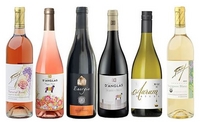Archives
September 2019
June 2019
May 2019
January 2019
August 2018
April 2018
March 2018
August 2017
May 2017
October 2016
July 2016
April 2016
October 2015
February 2015
December 2014
September 2014
July 2014
June 2014
May 2014
April 2014
October 2013
September 2013
August 2013
July 2013
June 2013
April 2013
March 2013
January 2013
December 2012
November 2012
October 2012
September 2012
August 2012
June 2012
May 2012
26 February 2015
Why You Should Ignore These Top 5 Wine Myths

Every culture has their own myths and urban legends, but somehow people see these elaborate stories as true and continue to share them like a game of Chinese Whispers. A few old tales you may have heard regarding wine may be, ‘Wine o’Clock’ or ‘Wine doesn’t improve with age; I improve with wine’. These sayings are passed around quite often, but here are a few wine myths that shouldn’t be taken note of:
Organic Wine isn’t Real Wine
This most definitely is not the case. People assume that because the label on natural wine states ‘No Sulphites’, this takes away the taste and overall experience of a bottle of wine that does. Preservative free wine still contains sulphites, but only the ones which are naturally produced during the fermentation process. A typical sulphite level can range between 200-350ppm, whereas organic wine only contains 10-20ppm – a result of only natural sulphites. The taste, aroma and overall experience of relaxing with a glass of organic wine are identical to a glass that isn’t organic.
Expensive Wine is Better
An expensive bottle of wine is bought by many for various reasons; it shows a sense of wealth, makes your friends believe you have good taste; you’re cultured or because you believe the myth that expensive wine is better than anything you could buy with the spare change in your pocket. This isn’t true. Everyone has a different palate and a different nose, which means everybody’s experience is different – that’s whether it’s a £3.99 bottle from the corner shop or a £30+ bottle from a wine specialist.
Wine Improves With Age
Bad wine will always be bad wine. It doesn’t matter how long you wait, the chemical structure of wine changes over time which changes the taste and the finish. Once bottled, white wine is ready to drink which means there’s no need to wait. Special wines on the other hand should be stored for long periods. Preservative free wine has no additional sulphites and therefore has a shorter shelf life than regular wines. The choice is yours as to when you decide to sit back and relax with your glass of wine, whether it’s today or a couple of years from now. However, you can tell when wine has gone bad and isn’t worth enduring another sip when it begins to resemble the smell of cardboard, vinegar or even cooked cabbage. Another way to tell is by its appearance when it sits in the glass – it could be browner than usual or have bubbles in a non-sparkling wine.
Sweet Wines Have Added Sugars
Sweet wines are thought to contain more calories and added sugar due to their sugar content, while in reality this is down to the alcohol content. The alcohol hits you with high sugar carb calories, which negatively impacts your blood sugar levels. This is a main reason as to why sweet wines are usually reserved for special occasions or the holidays, for a time of celebration rather than a casual drink.
No Wine Before 5pm
5pm and onwards is seen as the socially acceptable time to pour a glass of wine, but in actual fact this can disrupt REM; your deep sleep stage at night. Although research has shown that the liver metabolizes and detoxifies alcohol better between 5pm and 6pm*, drinking before this time is better for you and your sleep.
*http://cornellsun.com/blog/2011/11/30/the-best-time-for-health-routines/